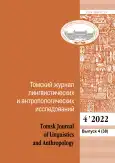“I GO DOWNSTREAM, AND YOU GO TOWARD THE SNOWSTORM”: EXPRESSIONS OF CARDINAL DIRECTIONS IN NGANASAN AND DOLGAN
- Авторы: Вагнер-Надь Б.1
-
Учреждения:
- Университет Гамбурга, Институт финноугроведеня
- Выпуск: № 4 (2022)
- Страницы: 73-83
- Раздел: ЛИНГВИСТИКА
- URL: https://bakhtiniada.ru/2307-6119/article/view/270395
- DOI: https://doi.org/10.23951/2307-6119-2022-4-73-83
- ID: 270395
Цитировать
Полный текст
Аннотация
This corpus-based study is dedicated to the topic of spatial orientation in two genetically unrelated but geographically neighboring languages, Ngnasan and Dolgan. Nganasan belongs to the Northern-Samoyedic branch of the Uralic language family, while Dolgan is a Turkic language. The Dolgans reached the peninsula later than the Nganasan and inhabited rather the eastern part. The goal is to typologically examine the linguistic realization of the directions of the so-called compass orientation. This is a very well-known fact that many indigenous languages, including many languages spoken in Siberia, do not know compass orientation. According to Brown (1983), speakers of many indigenous languages use three or only two cardinal points, however, in many languages, the speakers do not necessarily use the names of the compass direction but apply other concepts for expressing spatial directions. Brown (1983) identifies several sources of lexemes expressing the cardinal points, such as celestial bodies, which is the most often used source. It also occurs in the Samoyedic languages, e.g. in Selkup, but as we will see, not in the closely related Nganasan. Atmospheric features such as wind, seasons, blizzards, or environment- specific features such as a mountain, forest, or tundra can be metaphorically extended, thereby acting as the conceptual source of cardinal directions. The study follows Brown's typologization and tries to classify the results into their typological categories. We will find similarities and differences between the two languages regarding the conceptual sources. Both languages rely on the so-called landmarks for orientation in the surrounding areas, such as tundra, forest, river, or mountain, but beyond that, Nganasan uses other, non-common categories as well. These reflect a connection to their way of life; thus, it can be interpreted as a culture-specific source, which in turn has its origin in the environment. In contrast, the Nganasans do not use rivers as orientation points at all, although they live partly on the same rivers. Also typical only for the Nganasan is the use of atmospheric features a conceptual source. It does not play a role in any way in the Dolgan.
Ключевые слова
Об авторах
Беата Вагнер-Надь
Университет Гамбурга, Институт финноугроведеня
Автор, ответственный за переписку.
Email: beata.wagner-nagy@uni-hamburg.de
доктор, профессор 35 Оверсайринг, Гамбург, Германия-22297
Список литературы
- Anikin E. A. Etimologicheskiy slovar' russkikh dialektov Sibiri. Zaimstvovaniya iz ural'skikh, altayskikh i paleoaziattskikh yazykov [Etymological dictionary of Russian dialects of Siberia. Borrowings from the Uralic, Altaic and Paleo-Asiatic languages]. Novosibirsk, 1997.
- Beöthy E. Die Bezeichnungen für Himmelsrichtungen in den finnisch-ugrischen Sprachen. Bloomington, 1967.
- Brykina M., Gusev V., Szeverényi S., Wagner-Nagy B. Nganasan Spoken Language Corpus (NSLC). Archived in Hamburger Zentrum für Sprachkorpora. 2018. Version 0.2. Publication date 2018-06-12. URL: http://hdl.handle.net/11022/0000-0007-C6F2-8 (accessed: 03.10.2021)
- Brown C. Where do cardinal direction terms come from? // Anthropological Linguistics. 1983. No. 25 (2). P. 121–161.
- Budzisch J., Ulrike Kahrs. Cardinal directions in Selkup. Finnisch-Ugrische Mitteilungen. 2020. No. 44. P. 1–19.
- Däbritz C. L. A grammar of Dolgan: a northern Siberian Turkic language of the Taimyr Peninsula. Leiden; Boston: Brill, 2022.
- Däbritz C. L., Kudryakova N. Stapert, Eugénie. 2019. INEL Dolgan Corpus. Version 1.0. Publication date 2019-08-31. http://hdl.handle.net/11022/0000-0007-CAE7-1
- Dolgikh B. O. Mifologicheskiye skazki i istoricheskiye predaniya nganasan [Mythological tales and historical legends of Nganasan]. М.: Nauka, 1976.
- Kuz’mina A. K ėtimologiam nazvanij mesjacev, storon sveta, zvezd i sozvediy v seľkupskom yazyke // Yazyki i toponimija. 1977. No. 4. P. 71–85 (in Russian).
- Lambert J.-L. Sortir de la nuit. Essai sur le chamanism nganasanne. (Etudes mongoles et siberiennes 32–33). Paris, 2002–2003.
- Kuznecova A., Kazakevich O., Joffe L. Ju., Helimskij E. Ocherki po sel'kupskomu yazyku. Tazovskiy dialekt [Essays on the Selkup language. Taz dialect]. М.: Iz-vo Mosk. un-ta, 1993.
- Mészáros Cs. Tvorcheskaja lichnost’ v istoriko-kul’turnom prostranstve [The role of cardinal directions in Sakha environmental perception]. Novosibirsk: Nauka, 2013. P. 454–462.
- Mietzner A. Spatial orientation in Nilotic languages and the forces of innovation. / Mietzner A., Ulrike C. (eds.): Directionality in grammar and discourse: case studies from Africa. Cologne: Köppe, 2012. P. 165–175.
- Mietzner A., Pasch H. Expressions of Cardinal Directions in Nilotic and in Ubangian Languages // SKASE Journal of Theoretical Linguistics. 2007. No. 4 (3). P. 17–32.
- Polyakova N. Ob"yektivatsiya sposobov strukturirovaniya zemnogo prostranstva v sel'kupskom i russkom yazykakh [Objectification of Ways of Structuring the Terrestrial Space in the Selkup and Russian Languages] // Vestnik TGPU (TSPU Bulletin). 2017. No. 3(180). P. 47–50 (in Russian).
- Polyakova N. Kontsept «prostranstvo» i sredstva yego reprezentatsii v sel'kupskom i russkom yazykakh [The concept of "space" and the means of its representation in the Selkup and Russian languages]. Tomsk, 2006.
- Stachowski M. Considerations on the System and the Origins of Terms for the Cardinal Points in the Dolgan Language // Incontri linguistici. 2010. No. 33. P. 233–243.
- Stachowski M. Über das Alter der dolganischen sprache // Türk Dilleri Araştımaları. 1996. No. 6. P. 123–130.
- Talmy L. How language structures space / Pick, H. & L. Acredolo (eds.): Spatial orientation: Theory, research and application. New York: Plenum Press, 1983. P. 225–320.
- Talmy L. 2000. Toward a cognitive semantics. Vol. 1. Cambridge, MA: MIT Press.
- Wagner-Nagy B., Szeverényi S., Gusev V. User’s Guide to Nganasan Spoken Language Corpus. Working Papers in Corpus Linguistics and Digital Technologies: Analyses and Methodology. 2018. Vol. 1. URL: https://ojs.bibl.u-szeged. hu/index.php/wpcl/issue/view/810 (accessed: 24.01.2021)
Дополнительные файлы







